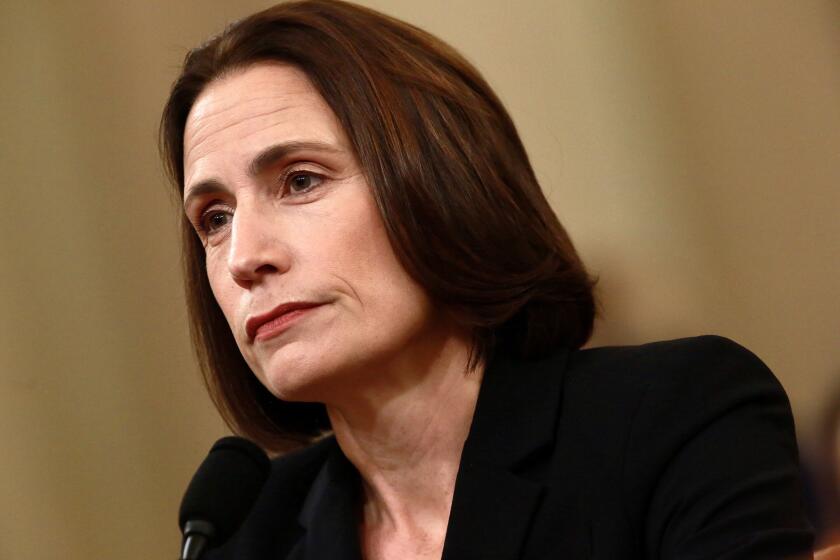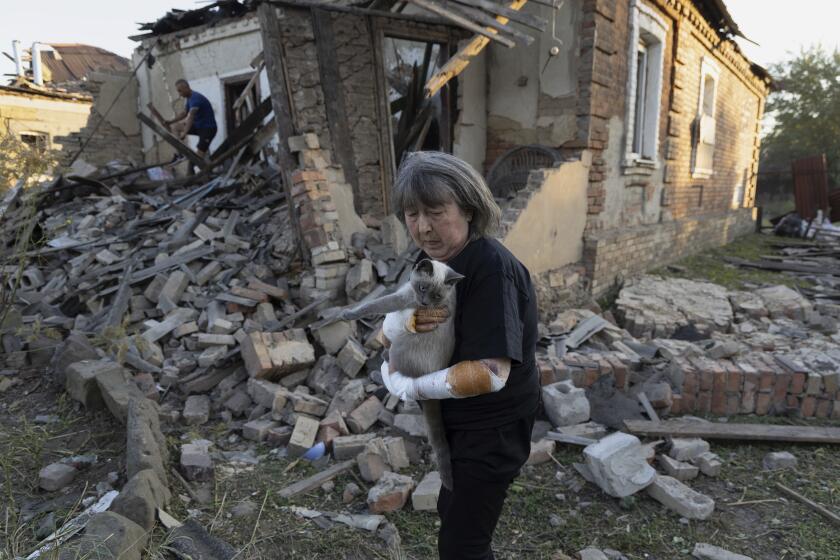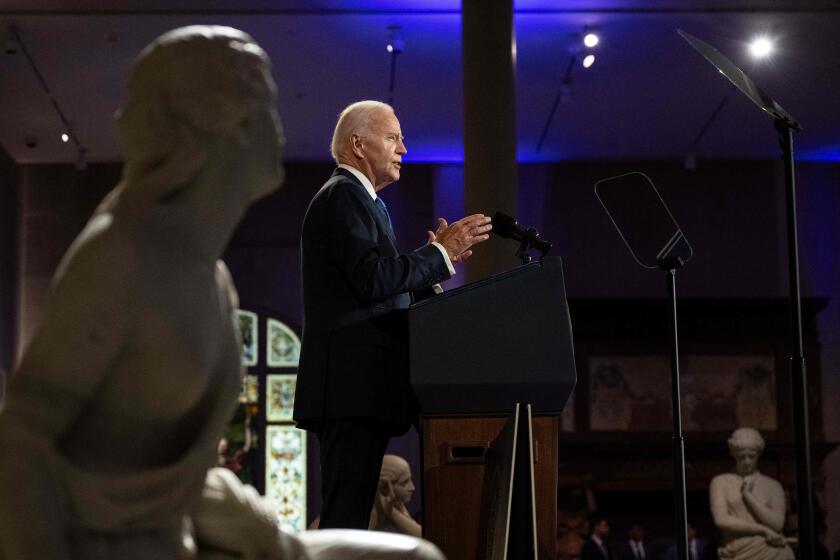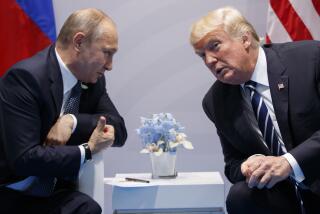Kyiv’s dark moment and America’s fateful choice
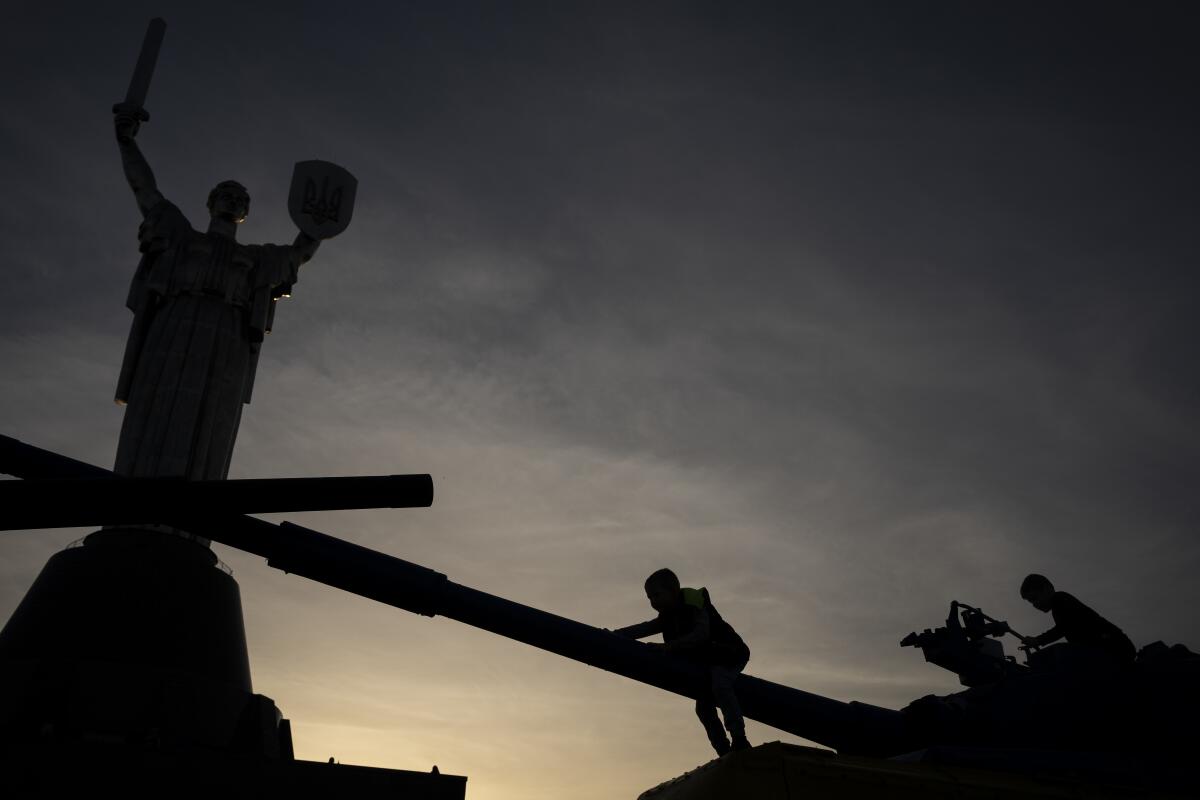
- Share via
What a difference a few weeks makes. When I left Kyiv in September for a short trip to the U.S., the late summer weather was perfect and the mood in Ukraine was upbeat and determined. There had been heavy fighting on the southern and eastern fronts — the long-awaited counteroffensive was going more slowly than many had hoped.
But by and large, the country I left was the Ukraine the world had been rooting for since February 2022: Little David pushing back against the Russian Goliath — plucky, resourceful, resilient and still surprising us with successes on the battlefield.
By the time I returned to Kyiv, the world had turned upside down. Hamas terrorists had launched a 21st century pogrom in southern Israel. Israelis were retaliating with overwhelming force in Gaza. Worst of all for Ukraine, the U.S. aid Kyiv relies on to prosecute the war was in jeopardy, with a largely friendly Senate and far less supportive House on a collision course as they debated President Biden’s request for another $61.4 billion in military and humanitarian support.
The former Trump administration Russia expert says Gaza and Ukraine “could be global-system-shifting wars, something like World War I and World War II.”
The mood in the city was subdued — as one of my friends put it, this is a “dark moment.” An early burst of support for Israel — huge blue and white flags projected on landmarks and billboards across Ukraine — had subsided into worry. Would the fighting in the Middle East steal the world’s attention? With winter approaching and more of last year’s brutal blackouts looming, stores were filled with shoppers buying bottled water and canned goods. The residents of my apartment building chipped in for an industrial generator.
Perhaps most striking, after nearly two years of rousing leadership by President Volodymyr Zelensky and his government, the official tone had shifted dramatically. The revered commander of the armed forces, General Valerii Zaluzhny, conceded in an interview that the counteroffensive had reached a stalemate. Zelensky objected to the use of that word, but he spoke solemnly about the darkening mood. “It is important for people to understand that what weighs on their hearts is seen,” he noted, freeing many people to open up about their doubts and fears.
And they have. “I’m struggling to handle it emotionally,” one 30-something professional woman admitted. (Like many of those I spoke with, she didn’t want her name used.)
The U.S. and its allies must not jeopardize the possibility of a peace agreement by softening their support for Ukraine right now.
But others seemed to welcome the breakthrough: “The situation has changed, and it’s time for society to wake up,” civil society activist Mykhailo Zhernakov explained. “We’re not going to take Crimea in a few weeks, as some people claimed we would, and it’s time we realized that.”
The pressing question, for Ukrainians and Americans: how to respond to the new reality.
Any Ukrainian reckoning starts with the situation on the ground. Not everyone is downbeat. There have been no flashy victories like last year’s in Kharkiv and Kherson, but many understand that expectations were unrealistic. Besides, Russia has also been unable to advance.
“Stalemate is not the same as failure,” one young civil servant offered. “It’s Russia that has failed. Remember, their goal is to wipe us off the map.”
Still, many people are asking themselves what needs to change.
Vladimir Putin has visited the Russian military’s southern headquarters to assess the state of Russian forces in Ukraine as the war heads into winter.
Some want Kyiv to do a better job of setting a goal — what exactly does victory look like? Others are looking for more honesty from government. “They ought to publish the casualty figures,” one neighbor argued. “People need to know the full price.”
Still others want Ukraine to ramp up domestic weapons production. “We need to be able to do more on our own,” a soldier maintained. One midcareer professional told me he was considering enlisting. “We’re running out of infantry,” he explained. “Sooner or later, we’ll all end up fighting.”
Most Ukrainians understand that time is not on their side. Russia has more resources and more manpower, and Putin faces no significant domestic opposition — he is free to wage a forever war.
Many people I spoke with were asking themselves what military aims are achievable and pondering potential scenarios for the endgame. But even now, even as the options dwindle, no one I encountered supports a cease-fire.
The White House will welcome President Zelensky on Thursday, a perfect chance for Biden to announce Kyiv will receive a new missile system and the U.S. will try to unlock frozen Russian assets as additional aid.
“Not until it’s the only resort,” one fighting-age man declared, “and we’re not there yet.”
The biggest unknown and biggest worry for Ukrainians is in Washington: Will the U.S. continue to help, and with what level of support?
The worse the prospects on the ground, the more assistance people hope for. “We can’t win the war as is, with the aid we’re getting from the U.S. and Europe,” one young man said flatly. “Just enough help so Moscow doesn’t win but not enough so we win.”
For many Ukrainians, the fighting in Gaza only strengthens their case. “It’s all connected,” argued financial analyst Valera Kondratenko, 33. “Iran, Russia, China: Any victory by any one of them, no matter how local, gives them all more confidence that they can achieve their goals with lawless aggression.”
But few of the people I spoke with see these arguments gaining traction in Washington, and many are wondering what went wrong — how did they so misunderstand when Biden promised “as long as it takes”?
“Don’t Americans see,” the civil servant asked, “that this is a bargain? No Americans are fighting or dying. We are, and we’re weakening our common enemy, the Russians.”
In the end, it comes down to a fundamental asymmetry between Ukraine and the U.S. Ukrainians feel they have no choice: “Either we fight, or we cease to exist,” as one woman put it.
America faces a fateful choice. As things get tougher in Ukraine this winter, the U.S. can back off, cutting aid and retreating into ourselves. Or the bitter news from the battlefield could clarify the stakes and simplify the stark choices we face.
Are we really prepared to walk away and let Russia win?
Tamar Jacoby is the Kyiv-based director of the Progressive Policy Institute’s New Ukraine Project and the author most recently of “Displaced: The Ukrainian Refugee Experience.”
More to Read
A cure for the common opinion
Get thought-provoking perspectives with our weekly newsletter.
You may occasionally receive promotional content from the Los Angeles Times.
